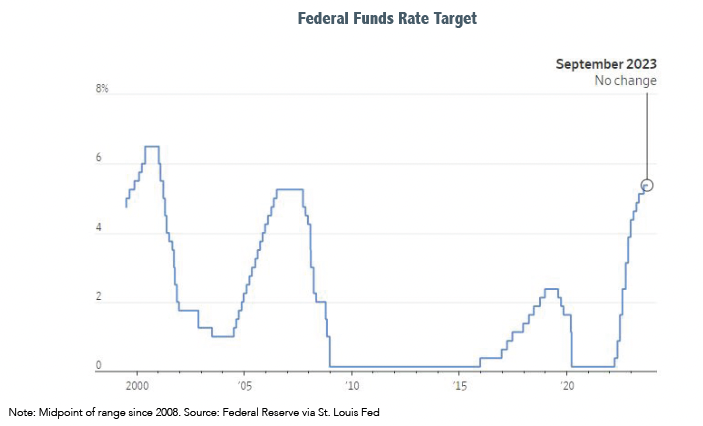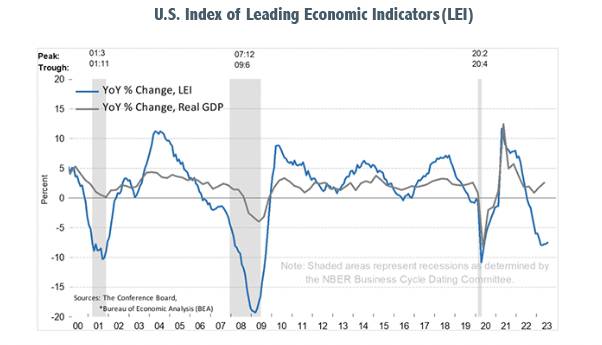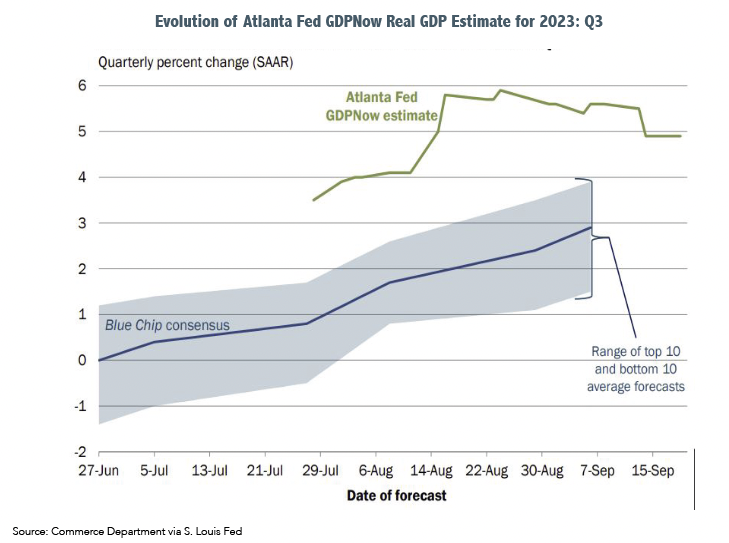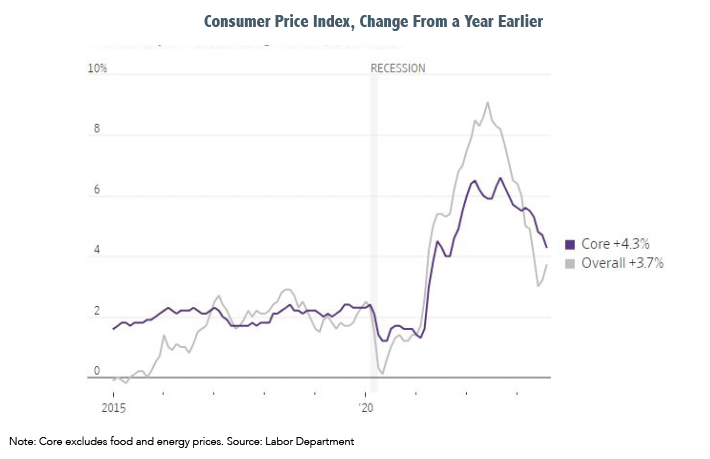As expected in mid-September the captain and crew of the good ship USS FOMC (Federal OpenMarket Committee) agreed to hold the fed funds rate on an even keel of 5.25%-5.50%. However, Fed Chairman Jerome Powell surprised markets by suggesting interest rates will not be falling as much or as fast as previously expected. This higher for longer posture was welcome news to fixed-income investors who had been enduring the windless seas of a zero-bound policy for too long. With interest rates at levels not seen in 16-22 years (depending on maturity) and above current inflation rates, bonds are once again generating real (after inflation) returns.
 Unfortunately, higher for longer is an unwelcome prospect for borrowers facing increased financing costs on big-ticket items like homes, automobiles, and heavy equipment and for those paying sky-high credit card rates. The Federal Reserve is determined to bring inflation down to its 2% target by trying to reduce demand and thus far, the results are mixed. No one can know if its desired outcome will be successful without a season of pain. Captain Powell, with a firm hand on the tiller, has been trimming the Fed’s monetary sails amidst numerous changes in latitudes, hoping to avoid triggering a recession or reigniting inflation. If the Fed’s 2% destination is to be reached safely and smoothly, it will require skilled navigation and an all-hands-on deck effort.
Unfortunately, higher for longer is an unwelcome prospect for borrowers facing increased financing costs on big-ticket items like homes, automobiles, and heavy equipment and for those paying sky-high credit card rates. The Federal Reserve is determined to bring inflation down to its 2% target by trying to reduce demand and thus far, the results are mixed. No one can know if its desired outcome will be successful without a season of pain. Captain Powell, with a firm hand on the tiller, has been trimming the Fed’s monetary sails amidst numerous changes in latitudes, hoping to avoid triggering a recession or reigniting inflation. If the Fed’s 2% destination is to be reached safely and smoothly, it will require skilled navigation and an all-hands-on deck effort.
Equities, which unexpectedly posted outsized gains in the year’s first half, cooled off during the third quarter. After such a large, fast run-up, a consolidation phase is to be expected. Such selloffs help dampen rampant speculation and allow for corporate earnings to catch up, bringing valuations back in line with historical norms. Bonds treaded water during 3Q-23 as interest rates bounced up and down in response to the latest economic and inflation data. Some analysts believe the bull that few saw coming still has legs, while others believe it has run its course for the time being and a continued consolidation or side-ways trend is in order before another leg up.
There has been an interesting divergence in economic data as evidenced by the Index of Leading Economic Indicators (LEI) and an extremely inverted yield curve. Both have been predicting a recession that has not yet materialized. Also, the Conference Board has been forecasting a recession for over a year and continues to expect a slight contraction in 4Q-23 and 1Q-24. The ISM Manufacturing Index is under 50%, a level normally associated with economic contractions. Finally, the U.S. budget deficit at $1.5 trillion year-to-date through August is far ahead of last year’s pace and while it has improved since COVID, it represents a percentage of GDP (Gross Domestic Product), not seen since the late stages of the Cold War. Once the lag effects of prior Fed rate hikes kick in, many economists believe there is an increased likelihood of slower growth which could reduce corporate earnings, multiples, and valuations. 
Despite those negatives, investor sentiment shifted this year toward a goldilocks environment (not too hot, not too cold) due to falling inflation, no sight of a recession on the horizon and rising corporate earnings estimates. Inflation in August, as measured by year-over-year CPI (Consumer Price Index) was 3.7% and Core CPI (excluding food and energy) came in at 4.3%, both substantially below year-ago readings. The Atlanta Fed GDPNow forecast for 3Q-23 is a whopping 4.9% annualized (after inflation), up from 2.4% in 2Q-23. With that much momentum, mostly driven by consumer spending, it is unlikely to slow down much in 4Q-23, which is causing seasickness for Captain Powell and his crew aboard the USS FOMC. Even though the gap between job openings and job seekers is narrowing, there are still 8.8 million jobs available, and the unemployment rate is only 3.8%. Finally, analysts’ earnings estimates have been increasing, not falling. Equity performance is directly correlated with earnings and is the reason common stocks have historically been such good long-term investments.
Even though the Fed has not raised rates since July, market rates have increased since then. Rising interest rates can be attributed to a belief that inflation is not firmly contained or it could be due to other factors such as an increased supply of government debt at the same time demand for that paper is falling. The U.S. Treasury needs to fund our gargantuan federal debt and budget deficits and simultaneously, the Federal Reserve is unwinding its QE-3 (Quantitative Easing) program in which it purchased large quantities of bonds, trying to push market rates down during COVID. Now it is selling debt or allowing bonds it owns to roll off upon maturity in a process called Quantitative Tightening (QT). The Fed’s $8.1 trillion balance sheet more than doubled from $4.2 trillion in March 2020 to $8.9 trillion by May 2022. And then there is China, which has been reducing its holdings of Treasuries over the past ten years and accelerated those reductions after Russia invaded Ukraine. China now holds $800 billion in U.S. Treasuries compared with $1.3 trillion in 2013.
What all of this means is that even if inflation settles back down to the Fed’s 2% target rate, these other forces may conspire to keep market rates higher for longer, independent of the Federal Reserve. Again, fixed-income investors may welcome this new normal, especially if inflation is down and their interest income is up, increasing their purchasing power. As for borrowers, not so much. Investors would do well to remember the late Jimmy Buffett’s popular verse, “Changes in latitudes, changes in attitudes, nothing remains quite the same.” Markets are constantly changing latitude (up and down) from influences exerted by forces such as corporate earnings, labor disputes, interest rates, oil prices, inflation, government deficits, geo-political concerns, and other factors. Investors’ attitudes also wax and wane from overly optimistic to overly fearful, with neither extreme being a good place to reside. 
It’s also important to remember that those changing market influences cannot be predicted consistently over time. Investment strategies relying on predictive capabilities can lead to big mistakes from which it may be difficult to recover. Just as an experienced sailor will tighten and relax lines trimming the boat’s sails to optimize speed and stability, an investor with a ship-shape financial plan, supported by an experienced advisory crew, will likewise make adjustments to increase the probability of achieving worthwhile goals and enjoying the journey along the way. The only thing constant in life is change, but how we respond to it will dictate our personal latitude.
Best wishes for a pleasant fall season with calm waters and smooth sailing.
Samuel J. Taylor, CIMA®, AIF®, CRPC®
Wealthview Capital, LLC
